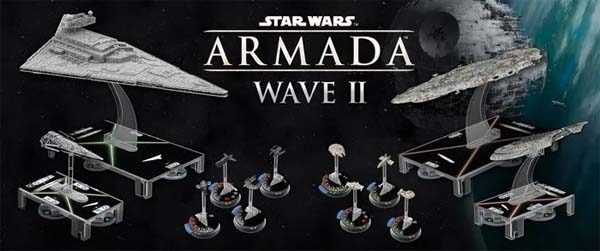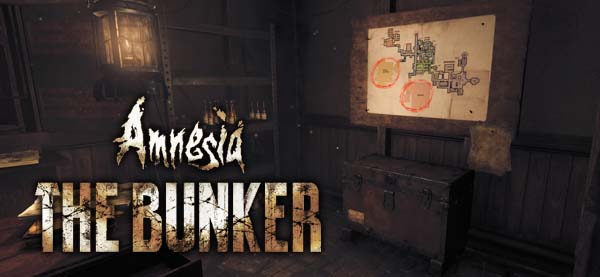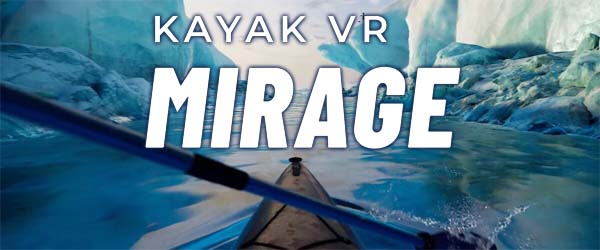
I might have been a bit unfair to X-Wing when I originally reviewed the Star Wars: Armada core set. I gave Armada a pretty glowing recommendation and praised it for giving the player more meaningful decisions and for fixing a handful of complaints that I had with X-Wing. But I kind of neglected the fact that the Armada core set has pretty much the same fundamental problem that stopped me from giving a similarly high grade to X-Wing: the limited content of the package.
X-Wing had three small ships, and a handful of alternate pilots and upgrades to add some replayability. But the game really needed some expansions to really come into its own. And I pointed that out in my review of X-Wing's core set, and docked its final score.
Don't get me wrong, Armada does offer more content in its core set than X-Wing did! It also has three ships, along with alternate ship cards and upgrades. But those three ships are different sizes and strengths, and there's ten fighter squadrons to go along with them. Armada's core set also includes the objective cards that helped to give that game more structured play, while X-Wing only had a couple of scenarios. So I still think that the Armada core set offers more value than the X-Wing core set.
However, I also knew that having a roster of expansion ships would improve the game, and I baked that assumption into my review for Armada. This may have been unfair to X-Wing, especially considering that the Armada core set has other problems that X-Wing doesn't have.
The core learning scenario doesn't do the game justice
It's been difficult for me to get friends into playing Armada. X-Wing has always seemed to be the more popular game. It took me a very long time to finally figure out why. During the past couple years of the COVID pandemic, it hasn't been viable to get together large groups for bigger board games, so I focused more on playing smaller, 2 and 3-player games to limit the number of people over at once. Games like X-Wing and Armada were ideal for that situation. In doing so, I tried a new technique for introducing friends to Armada that would hopefully get them up to speed faster, and which also seems to be much more successful than my earlier teaching attempts using the Learning Scenario.
Put simply: Armada's learning scenario is kind of crap. After teaching friends and co-workers to play the game through the learning scenario, their responses to the game has always been a resounding "meh". I then have to spend thirty minutes or an hour explaining [in vain] the merits of the full game to people who have already lost interest.
The learning scenario takes most of the strategic decisions away from the players.
The problem with the learning scenario is that it puts pre-configured fleets up against each other with no upgrade cards, no objectives, and no obstacles to navigate around. Without upgrades giving ships special abilities that can turn the tide of a game, and without objectives that give the players something to fight over, the early-game decisions of setting the starting queue of commands are really the only significant decisions in the entire game. Unfortunately, the learning scenario takes those decisions away from the players by recommending a default starting queue of commands! Once ships have been pointed at each other and met in the middle of the board, the last 3 or 4 turns of the learning game easily degrade into a passive process of drifting ahead and mindlessly rolling attack dice. Or the players forget to queue up a Navigate command, and the ships fly past each other in round 3, and spend the rest of the match trying to circle back around to get back in firing range.
Sid Meier, the designer of the original Civilization PC game has defined a game as "a series of interesting decisions". By that definition, the learning scenario of Star Wars Armada isn't even a game at all because all of the interesting decisions have already been made by the rule book before the players have taken a single turn. [More]
560a66ce-81de-4e24-8622-af57cd62681e|0|.0
Tags:Star Wars, Star Wars: Armada, Fantasy Flight, board game, miniatures game, expansion, capital ship, squadron, Imperial Raider, Star Destroyer, Interdictor, Home One, hyperspace, hyperdrive

While I was searching the PlayStation Store for some VR games to play on my PSVR2 headset (and on a PS4 VR headset that a friend let me borrow, since the PSVR2 headset isn't backwards-compatible), I stumbled upon an old sci-fi game that had apparently slipped under my radar when it released back in 2016. That game is a near-future space disaster game called ADR1FT. Unfortunately, this particular game doesn't have PSVR support, even though it apparently does have PC VR support, but it looked pretty and intriguing, so I bought it anyway.
Space station by Michael Bay and Roland Emmerich
In ADR1FT, the player plays as an astronaut who is a survivor of a catastrophic disaster aboard an orbital space station. The entire station has broken apart, and even the sections that are still intact are without power or life support. It is up to the player to explore the debris, look for any other survivors, and restore enough power and computer functionality to escape back to Earth in an Emergency Escape Vehicle (EEV). Personally, I think it's silly that an Emergency Escape Vehicle would be rendered useless in the event of an emergency that disables power and computer functionality. Kind of defeats the purpose of such a vehicle. One would think that such a vehicle would have an independent power supply and computer, and some way of detaching or ejecting the vehicle without the station being powered -- like, I don't know, some kind of explosive decompression of the clamps that attach the escape vehicle to the station, which works based on simple physics, rather than requiring power or computers.
But whatever, suspension of disbelief. I have to restore power to the main computer to get the escape pods to work. Fine. I can live with that contrivance.
The space station debris hovering over the Earth is a striking visual.
The space catastrophe itself is loaded with striking visual details. From the vistas of the Earth spinning below, to the fields of debris suspended in space, to water bubbles floating around certain chambers, ADR1FT really sells the look and feel of being trapped on a near-future destroyed space station. This includes the feeling of isolation, loneliness, and hopelessness of being trapped in space. In fact, it might be too good at selling this aesthetic, because it does so to the point of occasional frustration. [More]

After a couple years of rumors, Colossal Order has finally officially announced a sequel to Cities: Skylines. I would have thought that this would mean the end of new content for the first Cities: Skylines. But instead, we've seen a deluge of new content from the studio. I already reviewed the Plazas & Promenades expansion from last fall, but that expansion was followed by a "World Tour" of new content.
Most of this content comes in the form of "content creator packs", which are assets that were originally created by modders, but which Paradox and Colossal Order have bought and are selling in packs (and giving full credit to the creators, and presumably a cut of the sales). It's nice to see some big-name modders getting this formal recognition in the game, and an opportunity to profit a little bit from their hard work.
But there has also been some first-party content in the form of a mini-expansion called Financial Districts. This DLC adds a stock exchange, banks, and the ability to invest city funds into an in-game stock market. There is also another full expansion called Hotels & Retreats, but I'll be reviewing that separately.
Colossal Order is releasing one final barrage of DLC and mini-expansions before releasing a full sequel.
Insider trading
I'm going to start with the Financial Districts DLC, since it's the only content in this review that is actually first-party content created by Colossal Order, and it's the only of these DLCs that actually has any new rules and mechanics associated with it. The rest are all just collections of assets. Financial Districts isn't a full expansion. It's more in-line with previous DLC like the Match Day or Concerts DLC, in that it adds only one very specific thing, and a couple new mechanics.
This expansion adds a new type of office specialization: the titular Financial Districts. This district creates tall skyscrapers which belong to banking and investment firms. These buildings also generate increased tax revenue if near one of the expansion's ploppable buildings, the Stock Market. Combined with the "Tax Increase for Offices" policy, these districts can be incredibly profitable for the city.
Financial districts include tall office buildings for banks, investment firms, and the like.
As for the Stock Market itself, it allows the city to invest in a variety of fictional stocks for companies that supposedly exist in the city. Different stocks unlock based on the level of the Stock Market or based on certain criteria within the city (such as having enough of a certain type of building. The Stock Market is basically a cheat device for earning more money for your city. The performance of the various stocks all depend on factors within the city that the player has a degree of control over. For example, the player could bulldoze all your hospitals, let the healthcare stock crash, buy a bunch of it, then re-build those hospitals, and sell the stock after it shoots up. You can then also bulldoze the hospitals again and repeat the process until you have as much money as you want. The player can also affect the value of various stocks by simply increasing or decreasing the relevant budget sliders. [More]
c7a88169-4959-4ab6-af13-efa3b87d2518|12|2.7
Tags:Cities: Skylines, financial districts, skyscrapers, seaside resorts, mid-century modern, shopping malls, Korea, Japan, Africa, sports, stock exchange, bank

Amnesia: The Dark Descent almost single-handedly popularized the "hide and seek" and "run away" sub-genres of horror that would go on to influence everything from Outlast to >Observer_, and even the likes of P.T. and Visage (though I'm always surprised to remind myself that Silent Hill: Shattered Memories actually preceded Amnesia by a whole year). Amnesia also remained one of the more mechanically complex horror games, as more and more horror games leaned harder and harder into the paradigm of the "unarmed, defenseless player character" and erred closer and closer to walking sims. But even though Amnesia retained more mechanical complexity and more genuine threat than its contemporaries, it (and its sequels) never hit the level of complexity and action of a classic survival horror game.
Survival horror seems to be going through a renaissance of late, thanks in large part to Capcom hitting it out of the park with most of recent Resident Evil games. As such, Frictional Games wastes no time in telling the player that Amnesia: The Bunker ain't no walking sim. This is a return to old-school survival horror, but with modern conventions and twists. I have not been this impressed or excited by the opening hour of a survival horror game since booting up Resident Evil VII for the first time.
Death from German machine guns? Or death from an eldritch Beast? Take your pick.
Bullets and draw strings
Within the opening minutes of Amnesia: The Bunker, the player is dropped into a World War I trench with nothing but an empty revolver. There's no HUD at all. In order to check how many bullets you have in the revolver, you have to open the cylinder and look at how many bullets are left. To reload, you have to open the cylinder, drop out the empty shell casings, and manually reload each new bullet one at a time. Aiming and firing the gun is slow, clunky, and imprecise. There is also an ability to lean around corners and aim the gun.
After a short gun fighting tutorial in which the player is scripted to take damage, the game hands us some cloth with which to craft bandages. So the player has actual health, instead of just automatically healing over time, or losing sanity.
Then the game gives the player a flashlight. But unlike other contemporary horror games (or The Dark Descent), this flashlight doesn't run on batteries or oil. It has a simple friction motor that is recharged by repeatedly pulling a drawstring. Apparently, nothing in this game is going to be simple or effort-free. I do have to say though, that I wish the flashlight charge would last longer. Fumbling around in the dark to charge the flashlight (and risk making noise that could attract an enemy) is a wonderfully tense and anxiety-inducing mechanic, but having to do it every minute or 2 (whether there are threats present or not) gets tedious and annoying real quick. The fact that the light has to be recharged multiple times to explore a single moderately-sized room at a modestly brisk pace should have been a red flag that the light doesn't last long enough.
The flashlight and revolver require deliberate engagement from the player to use.
And then, if this weren't already feeling like a real survival horror game, within an hour of starting, you'll wander into a save room, complete with an item storage box and a map showing objectives and puzzle locations. One could easily mistake this for Resident Evil. Below the save room is a gasoline generator, which burns fuel to keep the bunker's electricity and lights running. But the supply of oil is limited, and spread throughout the bunker. And a warning sign is printed next to it, saying that the "beast" prefers to hunt in the dark. Keeping this generator running is one of the key mechanics of the game, since it (not your flashlight) is the primary source of light, and also the primary defense against the Beast.
This opening hour or 2 is so perfectly exactly what I want in a horror game! It is slow, tense, and methodical. I'm 2 hours in, and I haven't even seen the monster yet; I've only heard its threatening growls and the sound of it scuttling around within the walls and ceiling, seemingly ready to pounce at any moment. The game is already mechanically rich and varied, and full of risk / reward mechanics. Light and sound are both thematic effects and also full-fledged mechanics with strategy associated with them. It has an ever-present sense of dread and danger. The existence of the save room and item box suggests actual stakes for failure, and the presence of healing items and fuel suggest that the battle against this Beast will be one of attrition. It's looking to be a modern take on classic survival horror from one of the studios that innovated modern horror gaming.
Can I just give it an A+ already and start singing its praises on social media and YouTube? Well, let's actually play it and make sure. You know, just for shits and giggles. I mean, I haven't even seen the monster yet, so I should probably get at least that before I make up my mind, right?
The opening hours feel like pitch-perfect, classic survival horror.
[More]
1bdf3baf-4cce-48f8-bf09-155341cd0428|12|3.5
Tags:Amnesia: The Bunker, amnesia, Frictional Games, survival horror, horror, PS4, Steam, World War I, trench warfare, save room, revolver, flashlight, stopwatch, puzzle

The PSVR2 set for the PlayStation 5 is a pretty neat piece of hardware. I bought one at release, and have been enjoying it a lot. I might even write a review for it after I've finished playing all of the launch titles that I've bought. The PSVR2 has a critical problem though: there aren't very many games for it. There weren't any high-profile AAA games that had VR compatibility except for Gran Turismo 7 and Resident Evil: Village, which were both already a year or 2 old when the PSVR2 released. Horizon: Call of the Mountain was a release title too, but it's more of a stand-alone expansion pack for Forbidden West than a full game.
Since it isn't backwards-compatible with PS4 VR games (even though the PS5 was heavily advertised as being fully backwards-compatible with PS4 games), the PSVR2 doesn't have the benefit of the established PSVR library. Hit titles like Star Wars: Squadrons, Resident Evil VII, or Déraciné sadly aren't playable on the PSVR2 (unless they get PS5 upgrades from the developers, which doesn't seem likely).
There is a silver lining though. This lack of titles may have been bad for the PSVR2 (and its initial sales figures), but it may have been a good thing for some of the smaller titles available on the platform. Those small titles had an opportunity to shine without there being any massive blockbusters to steal the spotlight or players' cash. One such small standout it a little virtual vacation game called Kayak VR: Mirage. After Gran Turismo 7 and Call of the Mountain, Kayak might be the premiere launch title for PSVR2 (even though it is also available on PC VR platforms, and has been for about a year).
The lack of any blockbuster PSVR2 launch titles allowed smaller games to shine in the spotlight.
Virtual vacation, without the sunburn!
Out of the gate, I was very impressed with how this game looks. I'm used to VR titles looking a little grainy and blurry (especially the original PSVR titles I played), but Kayak VR looks sharp as a crystal on the PSVR2! I'm sure it help that the game is only rendering relatively small environments without any people, and it doesn't have to do any complicated A.I. calculations or anything like that. Nevertheless, these exotic locales look absolutely gorgeous. This game is a textbook example of a "virtual vacation", as just sitting, taking a deep breath, and admiring the view is often just as good as the actual game. I can almost smell the salt in the air!
But there is an actual game here, and it's kind of a racing game, I guess? When you're done admiring the views, you can chose to play several races on each of the game's 4 maps. You won't be racing against actual people in real-time, however, as these races are all time-trials against ghosts of other players.
Races are time-trials against ghosts of other players.
Each race requires the player to navigate through a series of gates in a specific order. But these aren't your typical, hovering magic gates that you see in most video games. The gates are physical poles hanging from physical wires strung up throughout the map. If you hit one of the poles with your body, the kayak, or the oar, you'll be docked several seconds from your time as a penalty. These gates are pretty narrow, so completing these races requires some fairly precise handling and control of the kayak. It gets surprisingly difficult.
[More]
4d854981-611a-4aad-83c4-07b0e9f160fd|6|3.0
Tags:Kayak VR: Mirage, Better Than Life, PlayStation 5, VR, PS5, virtual reality, PSVR2, kayak, water, ocean, beach, race, exercise, nature, vacation, Costa Rica, Antarctica, Norway, Australia
|

| 12 | | | | | | | 60 | | 11 | | | | | | | 55 | | 10 | | | | | | | 50 | | 09 | | | | | | | 45 | | 08 | | | | | | | 40 | | 07 | | | | | | | 35 | | 06 | | | | | | | 30 | | 05 | | | | | | | 25 | | 04 | | | | | | | 20 | | 03 | | | | | | | 15 | | 02 | | | | | | | 10 | | 01 | | | | | | | 05 |
|